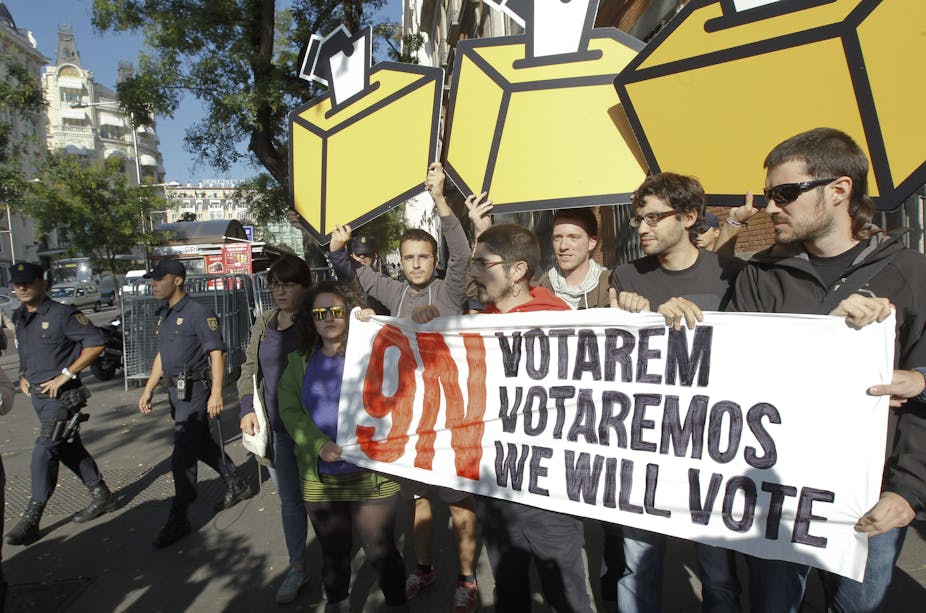“Catalans want to vote.” This is the message that has been emphasised with increasing strength since the beginning of what has been called the “Procés”. Hence, despite the attempts by the Spanish government to stop it, they plan to go ahead with a symbolic vote on independence on November 9. Less clear is what will happen next.
The idea behind the ballot was quite simple: after a period of significant citizen activism and mass public demonstrations by the separatist movement, the Catalan government – along with a number of civil society organisations – started calling for a referendum to decide whether or not Catalans should remain part of the Spanish state. It would be a vote similar to those held in Scotland recently and in Quebec in 1980 and 1995.
The problem is that, in contrast to the British and Canadian governments, the Spanish government has not recognised the right of the Catalan people to make such a decision. This stance has taken the debate down a very different route. Instead of weighing up the advantages and disadvantages of separation, opponents on both sides have spent much of the past two years arguing about whether or not the Catalans have the right to vote on such a decision.
That debate has culminated with the Catalan government calling a referendum which had not been agreed with the Spanish government. The Spanish government challenged it in the Constitutional Court, which ruled to suspend the vote until a decision about the constitutionality of the referendum was reached.
The lack of willingness to dialogue and find solutions by the Spanish government together with the determination by the Catalan government, pushed by the separatist movement, not to take any steps backwards has resulted in the strange proposal of a “non-official process of popular participation”.
This procedure should, theoretically, allow Catalans to cast a vote on the issue without committing an illegal act. The vote is not official, even if the Spanish government challenges it. There will be no census of voters, no official campaigns and polling stations will be run by volunteers who will count the votes without supervision from an official organisation.
The fact that the vote is unofficial and does not enjoy most of the standard democratic guarantees implies that the ultimate result will be skewed. Voting on the day is seen more as an act of protest and mobilisation than as one of decision making. For that reason, only those for whom the process is most important – the “yes” side – is expected to turn out en masse and an overwhelming majority of “yes” votes is taken for granted.
The interesting thing to look out for on Sunday is the number of people that actually participate rather than how they vote. A very low participation rate might be seen as a sign that interest in the vote has fallen. That would potentially make it harder for the Catalan government to continue to put pressure on the Spanish government for an official, binding vote. A high participation rate would encourage the Catalan government to continue to push for independence and even increase its efforts.
What comes afterwards?
But there is little consensus among pro-referendum leaders about the best route to take after the vote, given that the Spanish government has not shown any sign of willingness to relax its stance. The most likely outcome will be the calling of Catalan elections to allow voters to indicate which direction they want to take. However, it is not yet clear what the various Catalan parties will be offering them.
Some suggest giving up on negotiating and unilaterally breaking the union if a big enough majority supports it. Any negotiation with the Spanish government would then be left until after a declaration of independence.
Others are still reluctant about the idea of breaking the law and propose continuing to seek a negotiated solution – although how they might do it is not clear.
And those who have been more critical of the Catalan government and even supportive of the Spanish government, argue the project should be dropped so that the region can focus on other issues.
The latest polls show that a majority of Catalans still prefer the second route and are determined to find a negotiated solution. Nonetheless, a significant 25% are already willing to take the unilateral option.
Polls also show that the number of people supporting independence has stabilised at around 50% – and support drops to a minority when a “third way” or federalist option is put on the table. This would see Catalonia receiving greater and more protected competences.
The Spanish government could clearly change the situation in Catalonia by offering various different options for future governance. And even though the current government does not want to talk, Spanish polls are now being led by the newly formed Podemos party. The group has proposed a new constitution for Spain and the negotiation of a new solution to the Catalan problem by the Spanish government.
The situation is very open and is not clear that the trends shown in surveys will be sustained until election day. However, the possibility of a deep reconfiguration of Spanish politics opens up the possibility of new options for Catalonia, making it even harder to anticipate how this constitutional crisis will end.

